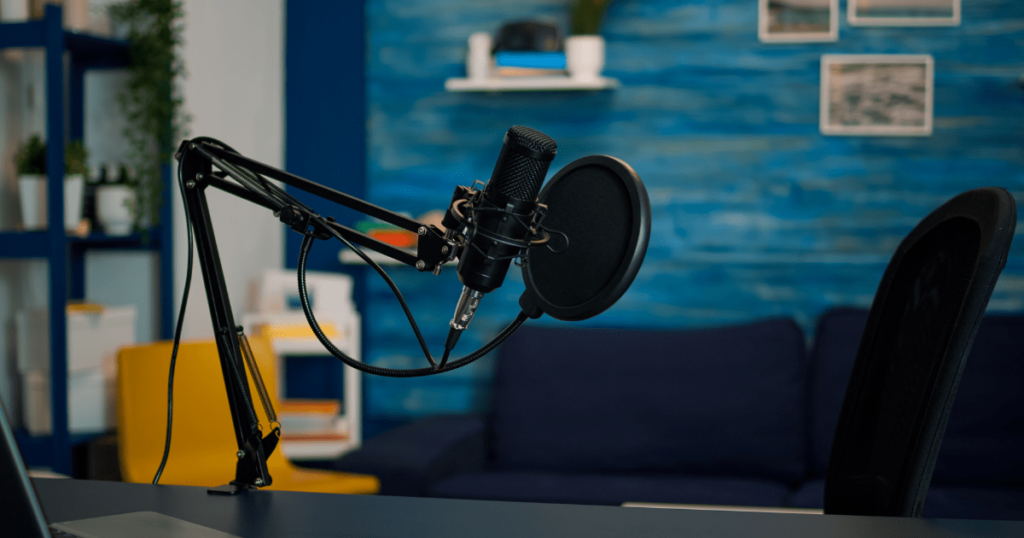Learn how to find your podcast niche and create unique content that resonates with your target audience in this step-by-step guide.
Note: This post does contain affiliate links. If you purchase any product/service through one of my affiliate links this website will receive a small commission at no additional cost to you. Thank you for your support!
When you’re staring at the hundreds of thousands of podcasts already out there, launching your own can feel like whispering in a crowded stadium. But here’s the thing: the most captivating voices aren’t necessarily the loudest – they’re the ones that speak to something specific, something distinct.
Finding your podcast niche isn’t just about picking a topic; it’s about discovering that sweet spot where your unique perspective meets an audience hungry for exactly what you have to offer. Whether you’re a weekend woodworker with a passion for sustainable practices, a marketing executive who moonlights as a mystery novelist, or a teacher who sees math in music, your distinctive angle could be exactly what’s missing in the podcast landscape.
Let’s explore how to uncover and develop that perfect niche that will make your podcast not just another voice in the crowd, but one worth listening to.
What’s a Podcast Niche and Why Should You Care?
Think of a podcast niche like your favorite local coffee shop. Sure, they serve coffee like Starbucks, but maybe they specialize in small-batch roasts from women-owned farms in Ethiopia, or perhaps they’re known for their unique lavender-honey lattes. That’s their niche – the special thing that makes coffee lovers choose them over the bigger chains.
Your podcast niche works the same way. It’s not just about picking a broad topic like “business” or “true crime” – it’s about finding your special angle. Maybe you’re not just covering true crime, but you’re focusing on historical mysteries in small-town America, or perhaps your business podcast specifically helps creative entrepreneurs navigate the world of NFTs.
Why does this matter? Let’s break it down with some real-world examples:
Instead of a generic “fitness podcast,” you might create “Fit After Fifty” – targeting active seniors with joint-friendly workouts and nutrition advice. Rather than another “movie review show,” you could launch “Sci-Fi Cinema for Scaredy-Cats” – helping horror-averse viewers enjoy science fiction without the jump scares.
Having a clear podcast niche helps you in three key ways:
- It makes your podcast easier to find. When someone searches for “workouts for seniors” or “sci-fi without horror,” boom – there you are!
- It helps you build a devoted audience. When listeners find a show that speaks directly to their specific interests or needs, they’re more likely to become loyal fans who share your content with others.
- It makes content creation simpler. Instead of trying to cover everything about movies or fitness, you know exactly what your lane is and can focus on serving your specific audience really well.
Think of your niche as your podcast’s superpower – it’s not about limiting yourself; it’s about focusing your energy where it can have the biggest impact.
Already have a podcast? Click here to switch to RSS.com and get SIX MONTHS FREE!
Your Roadmap to Finding Your Perfect Podcast Niche
Before we dive deep into each step, let’s sketch out the journey ahead. Think of finding your podcast niche like planning an expedition – you need a clear map to reach your destination. Here’s your step-by-step guide:
1. Mine Your Personal Gold
Start by asking yourself: What makes you light up during conversations? What topics do friends always come to you for advice about? Maybe you’re the go-to person for houseplant emergencies, or perhaps you have a knack for explaining complex tech in simple terms. Your sweet spot often lies where your enthusiasm meets your experience.
2. Scout the Landscape
Take a look around. What are other podcasters doing in your area of interest? If you’re passionate about sustainable living, for instance, notice whether existing shows focus more on zero-waste tips or eco-friendly technology. Sometimes the best opportunities lie in the gaps between existing content.
3. Sharpen Your Focus
This is where you get specific. Instead of “cooking,” maybe it’s “15-minute meals for busy parents.” Rather than “technology,” perhaps it’s “helping seniors navigate social media.” The more focused your niche, the easier it is to attract your ideal listeners.
4. Take Your Idea for a Test Drive
Before you invest in expensive equipment or commit to a weekly schedule, share your concept. Talk to potential listeners. Record a pilot episode. Post about your idea in relevant online communities. The feedback you receive here is gold.
5. Listen and Learn
Once you’re up and running, pay attention to what resonates with your audience. Which episodes get the most engagement? What questions do listeners ask? Let this real-world data guide your path forward.
Think of these steps not as rigid rules but as guideposts on your journey. The best podcasts often evolve naturally as hosts discover what their audience truly needs and wants.
Uncovering Your Secret Sauce: Exploring What Makes You Unique
Ever notice how you can talk for hours about certain topics without running out of steam? That’s exactly what we’re looking for in your podcast niche. Let’s dig into finding what makes you tick – and more importantly, what will keep you excited episode after episode.
Start With What Lights You Up
Grab a notebook and let’s do a quick exercise. Jot down your answers to these questions:
- What topics do you find yourself googling at 2 AM?
- Which conversations make you lose track of time?
- What do your friends always ask your advice about?
- What unique life experiences have shaped your perspective?
- Which professional skills come so naturally to you that you forget others find them challenging?
Find Your Unique Angle
Here’s where it gets interesting. Let’s say you’re passionate about cooking. But instead of being just another cooking podcast, maybe your angle is:
- “Kitchen Confidence for Reformed Microwave Addicts”
- “Global Cuisine Made Easy for Small-Town Groceries”
- “5-Ingredient Gourmet for Busy Professionals”
Your unique perspective might come from unexpected places. Perhaps you’re:
- An accountant who sees cooking through the lens of efficiency and planning
- A traveler who knows how to recreate international dishes with local ingredients
- A parent who’s mastered making fancy meals with limited time and picky eaters
The Sweet Spot Test
Once you’ve identified potential niches, ask yourself:
- Could I happily create 50 episodes about this topic?
- Do I have enough unique insights to add to the conversation?
- Does talking about this energize me?
- Can I see myself learning and growing within this niche?
Remember, you’re not just picking a topic – you’re choosing a conversation you want to be part of for the long haul. The best podcasts come from hosts who are genuinely excited to press record each time, eager to share their next insight or story.
Sizing Up the Scene: Smart Market Research for Your Podcast Niche
Think of market research like being a detective – you’re not just gathering clues about what’s out there, you’re uncovering golden opportunities others might have missed. Let’s break down how to do this without getting overwhelmed.
Scope Out the Competition (But Make It Fun)
Turn your commute or workout time into research hours. Subscribe to 3-4 podcasts in your potential niche and ask yourself:
- What makes you hit that 30-second skip button?
- Which moments make you grab your phone to take notes?
- What questions are left unanswered?
- What topics keep coming up that could use a fresh take?
Pro tip: Create a simple spreadsheet with three columns: “What I Love,” “What’s Missing,” and “My Unique Angle.”
Find Where Your People Hang Out
Your future listeners are already out there talking about your topic. You just need to find them:
- Join Facebook groups in your niche
- Follow relevant hashtags on Instagram and TikTok
- Browse Reddit threads
- Check out Discord communities
- Read comments on popular YouTube channels in your space
Look for patterns in the conversations:
- What questions keep popping up?
- What frustrations do people share?
- What solutions are they seeking?
Test the Waters
Before diving in headfirst:
- Post a question in these communities about your podcast concept
- Share a potential episode outline
- Create a quick poll about topic ideas
- Ask what people wish existing podcasts would cover better
Check the Growth Potential
Ask yourself:
- Is this topic tied to a passing trend, or does it have staying power?
- Are there natural subtopics you could explore?
- Could you bring in interesting guests or experts?
- Are there businesses in this space that might want to collaborate?
Quick Reality Checks
🟢 Green Flags:
- Active online communities
- Regular discussions and questions
- Multiple angles to explore
- Clear audience pain points you can address
🔴 Red Flags:
- Very few active discussions
- Oversaturated market with big-budget competitors
- Limited scope for fresh content
- Low engagement in existing communities
Remember, you’re not looking for an empty space – you’re looking for a space where you can add something valuable to the conversation. Sometimes the best opportunities are in crowded markets where you can bring a fresh perspective or better solution.
Finding Your Secret Weapon: Your Unique Voice & Expertise
You know that feeling when someone explains something in a way that finally makes it click? That’s what happens when expertise meets the right perspective. Let’s uncover what makes your take special.
Unpack Your Experience Backpack
We all carry around expertise we don’t even realize we have. Let’s inventory yours:
✦ Professional Superpowers
- What problems do you solve effortlessly at work?
- Which skills have you mastered that others find daunting?
- What industry insights do you take for granted?
✦ Life Experience Gold
- What challenges have you overcome?
- Which lessons did you learn the hard way?
- What journeys have shaped your worldview?
✦ Hidden Talents
- What do friends always ask you to help with?
- Which topics make you lose track of time when explaining?
- What unconventional solutions do you often discover?
Connect the Unexpected Dots
Sometimes the most compelling insights come from unusual combinations. For example:
- A therapist who’s also a gamer might offer unique insights into digital relationships
- An architect who loves cooking might see recipe development through a design thinking lens
- A kindergarten teacher who runs marathons might have fresh takes on building patience and persistence
Turn Your “Weird” Into Wonderful
Those quirks you might be tempted to hide? They’re often your biggest differentiators:
- Your dad jokes might make complex topics more approachable
- Your obsession with organization could help others create better systems
- Your experience living abroad might offer fresh perspectives on common challenges
The “Only You” Test
Ask yourself:
- What experiences have I had that give me a different angle?
- Which combination of skills makes my perspective unique?
- What conventional wisdom do I respectfully disagree with?
- What do I wish someone had told me when I started?
Remember: Expertise isn’t just about certificates and degrees. It’s about the unique lens through which you view your topic and the authentic way you share your insights. Your listeners aren’t just seeking information – they’re seeking your perspective on that information.
Refine Your Podcast Niche: From Broad Concept to Sharp Focus
You’ve done the soul-searching and market detective work – now it’s time to sharpen your podcast concept until it gleams. Think of this stage like a master chef reducing a sauce: you’re boiling down all your insights into something rich and potent.
Start with your “three-circle sweet spot.” Draw three overlapping circles: your passions, your expertise, and what your target audience craves. Where these circles meet is your podcast’s natural habitat. For instance, if you’re a former chef who loves science and notice people struggling with kitchen chemistry, your niche might be “The Kitchen Scientist: Where Cooking Meets Chemistry.”
Getting Specific (But Not Too Specific)
Let’s play the “narrow it down” game. Take your broad concept and keep asking “for whom specifically?” and “what exact problem am I solving?” until you hit the sweet spot. For example:
Broad: A podcast about personal finance
Better: Financial planning for creative freelancers
Best: “The Freelancer’s Money Guide: Financial Freedom for Digital Artists”
The trick is finding what I call the “Goldilocks zone” – specific enough to attract dedicated listeners but broad enough to keep creating fresh content. Ask yourself: Could you easily write down 50 episode topics? If yes, you’re probably in the right zone.
Your Unique Value Proposition: The “Only You” Factor
Here’s a powerful exercise: Complete this sentence:
“My podcast is the only one that combines , , and _ to help achieve __.”
For example: “My podcast is the only one that combines behavioral science, stand-up comedy, and parenting expertise to help overwhelmed parents raise confident kids while keeping their sanity.”
Test Drive Your Niche
Before you invest in expensive equipment, take your concept for a test drive:
- Create a mock episode outline
- Share it in relevant online communities
- Host a focus group over coffee with 3-5 potential listeners
- Notice which aspects make people lean in with interest
- Pay attention to the questions they ask – these are often clues to what’s missing in your niche
Remember the “pivot potential” – your niche isn’t carved in stone. Think of your first 10 episodes as your pilot season. Watch what resonates, what questions keep coming up, and where your audience pulls you. Some of the best podcasts today evolved significantly from their original concept.
Keep this mindset: You’re not just picking a lane; you’re creating a space where your voice, your expertise, and your audience’s needs dance together. When you hit that sweet spot, you’ll know – because the content ideas will flow naturally, and your audience will tell you, “It’s like this podcast was made exactly for me.”
This revision provides more concrete examples, actionable exercises, and memorable metaphors while maintaining the key information from the original. It’s also structured more clearly with distinct subsections and specific action items.
Know Your Listener: Building Your Podcast Around Your Audience
Imagine throwing a dinner party. You wouldn’t serve spicy curry to guests who can’t handle heat, right? The same goes for your podcast – understanding your listeners isn’t just important, it’s everything. Let’s dive into how to become your audience’s favorite show.
Create Your Listener Avatar
Get specific about who you’re talking to. Instead of a vague “business professionals,” think “Sarah, 32, startup marketing manager who listens during her morning commute and wants actionable tips she can implement same-day.”
Answer these key questions about your ideal listener:
- Where do they consume podcasts? (Commute, gym, doing chores?)
- What’s keeping them up at night?
- What’s their secret dream?
- What other podcasts do they love (and why)?
- What makes them hit subscribe… or unsubscribe?
Speak Their Language: Finding Your Podcast’s Voice
Think about your listener’s favorite conversations.
Are they:
- Quick and punchy like a coffee chat?
- Deep and thoughtful like a late-night discussion?
- Light and fun like catching up with a friend?
- Direct and practical like a mentoring session?
Your podcast’s tone should feel like their preferred conversation style. For example, if you’re targeting busy parents, maybe your episodes are structured like quick, encouraging pep talks. For aspiring entrepreneurs, perhaps you use a mix of storytelling and practical frameworks they can apply immediately.
Content That Sticks: The Perfect Episode Formula
Create your episode template based on how your audience learns best:
- Are they looking for quick wins? Structure 20-minute episodes with three actionable takeaways
- Do they love stories? Lead with a compelling narrative before diving into lessons
- Are they analytical? Break down concepts step-by-step with real-world examples
- Do they multitask while listening? Keep segments short and use clear transition signals
Mix evergreen content (always relevant) with timely topics (trending now) to keep your feed fresh and valuable. Think 80% timeless, 20% timely as a starting ratio.
Building Your Podcast Community
Turn passive listeners into active community members:
- Create episode-specific hashtags for social media discussions
- Start each episode with a community spotlight or listener win
- End with a specific question or challenge for listeners to discuss
- Consider a private community space (Facebook group, Discord server) for deeper connections
- Make it easy to engage – use link.tree or a simple landing page for all community touchpoints
The Feedback Loop: Growing With Your Audience
Think of your first 10 episodes as a pilot season. Pay attention to:
- Which episodes get the most downloads?
- What segments generate the most social media buzz?
- Which topics prompt listeners to reach out?
- What questions keep coming up in your community?
Use these insights to evolve your format. Maybe your planned 60-minute deep dives need to become 30-minute focused sessions. Or perhaps your audience wants more guest interviews than solo episodes.
Remember: Your most engaged listeners will tell you exactly what they want – through their actions, questions, and feedback. Your job is to listen as carefully to them as they listen to you.
From Niche to Notable: Your Podcast Journey Starts Now
Remember that local coffee shop metaphor we discussed earlier? Just like they didn’t become the neighborhood’s favorite overnight, your podcast journey is about to begin with that first bold step. You’ve got your map now – let’s put it to work.
Your Next 24 Hours:
- Open your notebook or word processor and write down your “three-circle sweet spot” – where your passion, expertise, and audience needs intersect
- Draft three potential podcast titles that reflect your unique angle
- Join two online communities where your future listeners hang out
Your First Week:
- Record a 5-minute test episode using just your phone
- Share your concept with three people who fit your listener avatar
- List 20 potential episode topics (if you struggle, your niche might need tweaking)
Here’s the truth about finding your podcast niche: it’s not about being perfect; it’s about being perfectly you. Whether you’re that architect who sees cooking through a designer’s lens or the marathon-running kindergarten teacher with unique insights on persistence, your distinct perspective is your superpower.
Think of each episode as a conversation with a friend who shares your fascination with your topic. That authenticity will attract the right listeners – the ones who’ll tell their friends, “You have to hear this podcast. It’s like they’re reading my mind!”
Your Next Chapter Starts Here
Remember: Every successful podcaster started exactly where you are now – with an idea, some butterflies in their stomach, and the courage to press record. Your niche isn’t just a topic; it’s your unique contribution to the conversation. That “weird” combination of interests and experiences you bring? That’s exactly what someone out there is searching for.
So take some coffee shop wisdom: don’t try to be everyone’s cup of coffee. Be that distinctive lavender-honey latte that keeps your listeners coming back for more.
Ready to turn your idea into reality? Start a podcast today.
Read More Posts in my Podcasting Series
- Expert Round Up – Tips for First Time Podcasters
- How to Promote a Podcast: Common Mistakes in Promoting
- How to Use Podcasts to Build Your Personal Brand and Network
- How to Use Podcasts to Connect with Your Target Audience
- How to Use Podcasts to Land Your Dream Job
- Podcasting For Authors – Can You Sell More Books with a Podcast? YES!
- The Importance of Branding in Podcasting
- Legal Considerations for a Podcast – Are You Podcasting Legally?
- Does Podcast Equipment Still Matter?
- 6 Fun Ideas for Promoting Your Podcast
- The Importance of Storytelling in Podcasting
- Why Starting a Podcast Is the Perfect Side Hustle
- Podcasting for Your Brand – Make Your Business Famous
- How to Measure the Success of Your Podcast
- How to Turn Your Podcast into a Live Event – Building Community Around Your Podcast
- Podcasting as an Educator – Step By Step Guide to Sharing Your Lessons on a Mobile Medium
- Podcasting for Comedians – Using Your Podcast to Book More Shows
- Podcasting for Musicians – Step By Step Guide to Using Your Podcast to Promote Your Music
- Podcasting for NonProfits – Everything You Need to Know
- Step By Step Guide to Maximizing Your Podcast Donations

























